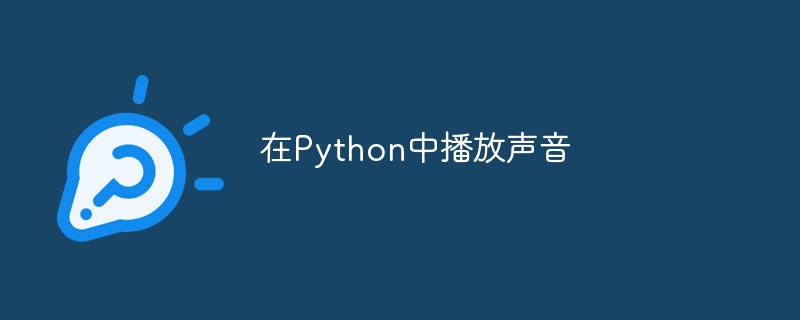

Let’s first take a look at the playsound library, which provides a simple and straightforward solution for playing sound files in Python. Due to its minimal setup requirements, developers can quickly integrate audio playback into their applications with a single function call. However, for more advanced audio functionality, we delved into two popular libraries: pygame and pyglet. Pygame is a powerful multimedia library known for its ability to handle audio, graphics, and user input.
Let's go on this audio adventure together and explore the possibilities of sound in Python applications.
A quick and efficient way to play audio files in Python is to use the playsound package. No complicated setup is required as it provides a simple interface to play audio. Before proceeding, the playsound library must be installed using the pip package manager.
Once everything is set up, you can import the library and play the audio file by using the playsound function. This method takes as input the path to a sound file and plays the sound file using the system's built-in audio player. It also supports WAV, MP3 and other audio formats.
The playsound library also provides other functions, such as controlling volume and blocking program execution until the sound has finished playing. This allows you to effectively synchronize sound playback with other parts of your code.
The Chinese translation offrom playsound import playsound # Provide the path to your sound file sound_file = "path/to/your/sound/file.mp3" # Play the sound file playsound(sound_file)
While the playsound library is sufficient for basic audio playback, if you need more complex functionality, you can use the 'pygame' library. The popular multimedia library Pygame provides a complete feature set for managing input, graphics, and audio.
To use 'pygame' for audio playback, you must install it via pip. Once setup is complete, you can import the necessary modules and initialize the pygame library to start using its audio functionality.
The pygame.mixer module is one of the basic parts of 'pygame' used for audio playback. It provides tools to manage multiple simultaneous sounds, control volume, and load and play audio files. Before using "pygame" to play sounds, you must first call pygame.mixer.init() to initialize the mixer module. The audio system is now ready for playback.
Python Game Mixer. The sound file can then be loaded by passing the file location as input to the Sound() method. Once a sound is loaded, it can be played using the sound object's play() function. You can also modify the playback speed, volume, and effects like loops and fades.
'pygame' allows you to control multiple sounds at the same time, in addition to playing a single sound. By combining sounds and adjusting their volumes individually, complex audio compositions can be created. Due to its adaptability, 'pygame' is an excellent choice for development of interactive applications and games requiring complex audio playback.
The Chinese translation ofimport pygame # Initialize the pygame mixer pygame.mixer.init() # Load a sound file sound_file ="path/to/your/sound/file.wav" sound = pygame.mixer.Sound(sound_file) # Play the sound sound.play() # Wait for the sound to finish playing pygame.time.wait(int(sound.get_length() * 1000))
While the "playsound" library provides a simple and straightforward solution for basic audio playback in Python, developers looking for more advanced features and flexibility can turn to "pyglet". Pyglet is a powerful multimedia library that provides an extensive set of tools for audio and video playback, graphical user interfaces, and more. In this section, we'll dive into pyglet's capabilities for advanced audio playback.
Pyglet provides a high-level interface for loading and playing audio files through its pyglet.media module. Using 'pyglet' you can go beyond basic sound playback and take advantage of more advanced features.
'pyglet's support for positional audio is one of its most notable features. By simulating sound sources in a three-dimensional environment, it enables a more realistic audio experience. By defining the position, speed, and direction of a sound source, you can produce a simulated audio environment in which sounds appear to come from different directions and distances. This feature is especially helpful for applications such as games, virtual reality experiences, or simulations.
'Pyglet' includes features such as volume control, pitch shifting, and custom audio streaming, in addition to positioning audio. You can use the volume control to change the loudness of certain sounds or create dynamic sound effects. You can change the pitch of a sound with Pitch Shift, which can be useful for creating original sound effects or changing the speed of audio playback. Custom audio streams make it possible to design and modify audio streams in real time, enabling interactive and dynamic audio experiences.
Additionally, 'pyglet' offers flexibility in handling various sound file types, as it supports multiple audio formats, including WAV, MP3, OGG, and FLAC. Additionally, it has tools for managing multiple simultaneous sounds, streaming audio, and coordinating audio playback with other parts of the program.
Python programmers now have the power and tools they need to create realistic audio experiences. Whether you're making a game that requires accurate sound localization, a multimedia application that requires dynamic audio effects, or you're experimenting with virtual reality simulations, "pyglet" provides the tools you need to fulfill your audio vision.
要使用 "pyglet" 播放声音,首先必须创建一个 pyglet.media 对象。这个对象处理音频文件的加载和播放。您可以通过创建一个 pyglet.media.StaticSource 对象并将其作为参数传递给文件路径来加载声音文件。
使用播放器对象的play()函数,您可以在加载完成后播放声音。"pyglet"提供的其他功能包括音高变换、音量控制以及设计自己的音频流源的能力。
import pyglet # Create a pyglet player object player = pyglet.media.Player() # Load a sound file sound_file = "path/to/your/sound/file.wav" source = pyglet.media.StaticSource(pyglet.media.load(sound_file)) # Queue the source to the player player.queue(source) # Play the sound player.play() # Wait for the sound to finish playing pyglet.app.run()
Python提供了多个用于播放声音的库和工具,以满足不同的需求和复杂性水平。'playsound'库提供了一种简单的方法来进行基本的音频播放,而'pygame'和'pyglet'则提供了更高级的功能和灵活性。通过熟练掌握这些库,您可以轻松地将音频播放功能集成到您的Python项目中,无论是用于游戏、交互式应用程序还是多媒体体验。Python的音频功能提供了设计沉浸式和引人入胜的应用程序的能力,无论您在编程方面的经验水平如何。请记住,要发挥Python中音频播放的全部潜力,需要探索这些库提供的文档和示例。所以,请继续前进,开始尝试,让您创建的迷人音景让您的Python程序活跃起来。
The above is the detailed content of Play sound in Python. For more information, please follow other related articles on the PHP Chinese website!




